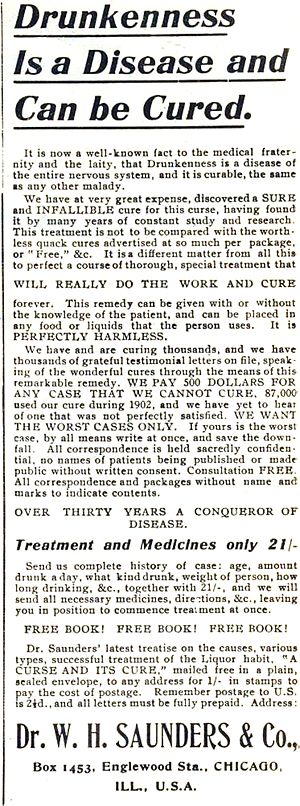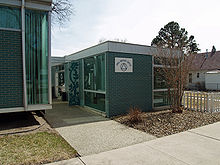| Alcohol dependence | |
|---|---|
 | |
| A 1904 advertisement labeling alcoholism a "disease" | |
| Specialty | Psychiatry |
The modern disease theory of alcoholism states that problem drinking is sometimes caused by a disease of the brain, characterized by altered brain structure and function.
The largest association of physicians - the American Medical Association (AMA) declared that alcoholism was an illness in 1956. In 1991, the AMA further endorsed the dual classification of alcoholism by the International Classification of Diseases under both psychiatric and medical sections.
Theory
Alcoholism is a chronic problem. However, if managed properly, damage to the brain can be stopped and to some extent reversed.
In addition to problem drinking, the disease is characterized by
symptoms including an impaired control over alcohol, compulsive thoughts
about alcohol, and distorted thinking. Alcoholism can also lead indirectly, through excess consumption, to physical dependence on alcohol, and diseases such as cirrhosis of the liver.
The risk of developing alcoholism depends on many factors, such
as environment. Those with a family history of alcoholism are more
likely to develop it themselves (Enoch & Goldman, 2001); however,
many individuals have developed alcoholism without a family history of
the disease. Since the consumption of alcohol is necessary to develop
alcoholism, the availability of and attitudes towards alcohol in an
individual's environment affect their likelihood of developing the
disease. Current evidence indicates that in both men and women,
alcoholism is 50–60% genetically determined, leaving 40-50% for
environmental influences.
In a review in 2001, McLellan et al. compared the diagnoses,
heritability, etiology (genetic and environmental factors),
pathophysiology, and response to treatments (adherence and relapse) of
drug dependence vs type 2 diabetes mellitus, hypertension, and asthma.
They found that genetic heritability, personal choice, and environmental
factors are comparably involved in the etiology and course of all of
these disorders, providing evidence that drug (including alcohol)
dependence is a chronic medical illness.
Genetics and environment
According to the theory, genes play a strong role in the development of alcoholism.
Twin studies,
adoption studies, and artificial selection studies have shown that a
person's genes can predispose them to developing alcoholism. Evidence
from twin studies show that concordance rates for alcoholism are higher
for monozygotic twins than dizygotic twins—76% for monozygotic twins and 61% for dizygotic twins. However, female twin studies demonstrate that females have much lower concordance rates than males. Reasons for gender differences may be due to environmental factors, such as negative public attitudes towards female drinkers.
Twin studies suggest that males are more likely to have a genetic
predisposition for alcoholism. However, this does not suggest that a
male who does have a genetic predisposition will become an alcoholic.
Sometimes the individual may never encounter an environmental trigger
that leads to alcoholism.
Adoption studies also suggest a strong genetic tendency towards
alcoholism. Studies on children separated from their biological parents
demonstrates that sons of alcoholic biological fathers were more likely
to become alcoholic, even though they have been separated and raised by
non alcoholic parents. Female show similar results, but to a lesser degree.
In artificial selection studies, specific strains of rats were
bred to prefer alcohol. These rats preferred drinking alcohol over other
liquids, resulting in a tolerance for alcohol and exhibited a physical
dependency on alcohol. Rats that were not bred for this preference did not have these traits.
Upon analyzing the brains of these two strains of rats, it was
discovered that there were differences in chemical composition of
certain areas of the brain. This study suggests that certain brain
mechanisms are more genetically prone to alcoholism.
The convergent evidence from these studies present a strong case for the genetic basis of alcoholism.
History
Historians
debate who has primacy in arguing that habitual drinking carried the
characteristics of a disease. Some note that Scottish physician Thomas Trotter was the first to characterize excessive drinking as a disease, or medical condition.
Others point to American physician Benjamin Rush (1745–1813), a signatory to the United States Declaration of Independence
— who understood drunkenness to be what we would now call a "loss of
control" — as possibly the first to use the term "addiction" in this
sort of meaning.
My observations authorize me to say, that persons who have been addicted to them, should abstain from them suddenly and entirely. 'Taste not, handle not, touch not' should be inscribed upon every vessel that contains spirits in the house of a man, who wishes to be cured of habits of intemperance.
— Levine, H.G., The Discovery of Addiction: Changing Conceptions of Habitual Drunkenness in America
Rush argued that "habitual drunkenness should be regarded not as a
bad habit but as a disease", describing it as "a palsy of the will". Rush expounded his views in a book published in 1808. His views are described by Valverde and by Levine:
Swedish physician Magnus Huss coined the term "alcoholism" in his book Alcoholismus chronicus (1849).
Some argue he was the first to systematically describe the physical
characteristics of habitual drinking and claim that it was a disease.
However, this came decades after Rush and Trotter wrote their works, and
some historians argue that the idea that habitual drinking was a
diseased state emerged earlier.
Given this controversy, the best one can say is that the idea
that habitual alcohol drinking was a disease had become more acceptable
by the middle of the nineteenth century, although many writers still
argued it was a vice, a sin, and not the purview of medicine but of
religion.
Between 1980 and 1991, medical organizations, including the AMA, worked
together to establish policies regarding their positions on the disease
theory. These policies were developed in 1987 in part because
third-party reimbursement for treatment was difficult or impossible
unless alcoholism were categorized as a disease. The policies of the
AMA, formed through consensus of the federation of state and specialty
medical societies within their House of Delegates, state, in part:
"The AMA endorses the proposition that drug dependencies, including alcoholism, are diseases and that their treatment is a legitimate part of medical practice."
In 1991, the AMA further endorsed the dual classification of
alcoholism by the International Classification of Diseases under both
psychiatric and medical sections.
Controlled drinking
The
disease theory is often interpreted as implying that problem drinkers
are incapable of returning to 'normal' problem free drinking, and
therefore that treatment should focus on total abstinence. Some critics
have used evidence of controlled drinking in formerly dependent drinkers to dispute the disease theory of alcoholism.
The first major empirical challenge to this interpretation of the disease theory followed a 1962 study by Dr. D. L. Davies.
Davies' follow-up of 93 problem drinkers found that 7 of them were
able to return to "controlled drinking" (less than 7 drinks per day for
at least 7 years). Davies concluded that "the accepted view that no
alcohol addict can ever again drink normally should be modified,
although all patients should be advised to aim at total abstinence";
After the Davies study, several other researchers reported cases of
problem drinkers returning to controlled drinking.
In 1976, a major study commonly referred to as the RAND report,
published evidence of problem drinkers learning to consume alcohol in
moderation.
The publication of the study renewed controversy over how people
suffering a disease which reputedly leads to uncontrollable drinking
could manage to drink controllably. Subsequent studies also reported
evidence of return to controlled drinking. Similarly, according to a 2002 National Institute on Alcohol Abuse and Alcoholism (NIAAA) study,
about one of every six (18%) of alcohol dependent adults in the U.S.
whose dependence began over one year previously had become "low-risk
drinkers" (less than 14 drinks per week and 5 drinks per day for men, or
less than 7 per week and 4 per day for women). This modern longitudinal
study surveyed more than 43,000 individuals representative of the U.S.
adult population, rather than focusing solely on those seeking or
receiving treatment for alcohol dependence.
"Twenty years after onset of alcohol dependence, about three-fourths of
individuals are in full recovery; more than half of those who have
fully recovered drink at low-risk levels without symptoms of alcohol
dependence."
However, many researchers have debated the results of the smaller
studies. A 1994 followup of the original 7 cases studied by Davies
suggested that he "had been substantially misled, and the paradox exists
that a widely influential paper which did much to stimulate new
thinking was based on faulty data."
The most recent study, a long-term (60 year) follow-up of two groups
of alcoholic men by George Vaillant at Harvard Medical School concluded
that "return to controlled drinking rarely persisted for much more than a
decade without relapse or evolution into abstinence." Vaillant also noted that "return-to-controlled drinking, as reported in short-term studies, is often a mirage."
The second RAND study, in 1980, found that alcohol dependence
represents a factor of central importance in the process of relapse.
Among people with low dependence levels at admission, the risk of
relapse appears relatively low for those who later drank without
problems. But the greater the initial level of dependence, the higher
the likelihood of relapse for nonproblem drinkers. The second RAND study findings have been strengthened by subsequent research by Dawson et al.
in 2005 which found that severity was associated positively with the
likelihood of abstinent recovery and associated negatively with the
likelihood of non-abstinent recovery or controlled drinking.
Other factors such as a significant period of abstinence or changes in
life circumstances were also identified as strong influences for
success in a book on Controlled Drinking published in 1981.
Managed drinking
As part of a harm reduction
strategy, provision of small amounts of alcoholic beverages to homeless
alcoholics at homeless shelters in Toronto and Ottawa reduced
government costs and improved health outcomes.
Legal considerations
In 1988, the US Supreme Court upheld a regulation whereby the Veterans' Administration
was able to avoid paying benefits by presuming that primary alcoholism
is always the result of the veteran's "own willful misconduct." The
majority opinion written by Justice Byron R. White echoed the District
of Columbia Circuit's finding that there exists "a substantial body of
medical literature that even contests the proposition that alcoholism is
a disease, much less that it is a disease for which the victim bears no
responsibility".
He also wrote: "Indeed, even among many who consider alcoholism a
"disease" to which its victims are genetically predisposed, the
consumption of alcohol is not regarded as wholly involuntary." However,
the majority opinion stated in conclusion that "this litigation does not
require the Court to decide whether alcoholism is a disease whose
course its victims cannot control. It is not our role to resolve this
medical issue on which the authorities remain sharply divided." The
dissenting opinion noted that "despite much comment in the popular
press, these cases are not concerned with whether alcoholism,
simplistically, is or is not a "disease.""
The American Bar Association "affirms the principle that dependence on alcohol or other drugs is a disease."
Current acceptance
Alcoholism is a disease with a known pathology and an established biomolecular signal transduction pathway which culminates in ΔFosB overexpression within the D1-type medium spiny neurons of the nucleus accumbens; when this overexpression occurs, ΔFosB induces the addictive state.
In 2004, the World Health Organization
published a detailed report on alcohol and other psychoactive
substances entitled "Neuroscience of psychoactive substance use and
dependence".
It stated that this was the "first attempt by WHO to provide a
comprehensive overview of the biological factors related to substance
use and dependence by summarizing the vast amount of knowledge gained in
the last 20-30 years. The report highlights the current state of
knowledge of the mechanisms of action of different types of psychoactive
substances, and explains how the use of these substances can lead to
the development of dependence syndrome." The report states that
"dependence has not previously been recognized as a disorder of the
brain, in the same way that psychiatric and mental illnesses were not
previously viewed as being a result of a disorder of the brain. However,
with recent advances in neuroscience, it is clear that dependence is as
much a disorder of the brain as any other neurological or psychiatric
illness."
The American Society of Addiction Medicine and the American Medical Association both maintain extensive policy regarding alcoholism. The American Psychiatric Association recognizes the existence of "alcoholism" as the equivalent of alcohol dependence. The American Hospital Association, the American Public Health Association, the National Association of Social Workers, and the American College of Physicians classify "alcoholism" as a disease.
In the US, the National Institutes of Health has a specific institute, the National Institute on Alcohol Abuse and Alcoholism
(NIAAA), concerned with the support and conduct of biomedical and
behavioral research on the causes, consequences, treatment, and
prevention of alcoholism and alcohol-related problems. It funds
approximately 90 percent of all such research in the United States. The
official NIAAA position is that "alcoholism is a disease. The craving
that an alcoholic feels for alcohol can be as strong as the need for
food or water. An alcoholic will continue to drink despite serious
family, health, or legal problems. Like many other diseases, alcoholism
is chronic, meaning that it lasts a person's lifetime; it usually
follows a predictable course; and it has symptoms. The risk for
developing alcoholism is influenced both by a person's genes and by his
or her lifestyle."
Certain medications including opioid antagonists such as naltrexone have been shown to be effective in the treatment of alcoholism.
Criticism
Some physicians, scientists and others have rejected the disease theory of alcoholism on logical, empirical and other grounds. Indeed, some addiction experts such as Stanton Peele are outspoken in their rejection of the disease model, and other prominent alcohol researchers such as Nick Heather have authored books intending to disprove the disease model.
Some critics of the disease model argue alcoholism still involves
choice, not total loss of control, and stripping alcohol abusers of
their choice, by applying the disease concept, is a threat to the health
of the individual; the disease concept gives the substance abuser an
excuse. A disease cannot be cured by force of will; therefore, adding
the medical label transfers the responsibility from the abuser to
caregivers. Inevitably the abusers become unwilling victims, and just as
inevitably they take on that role. They argue that the disease theory
of alcoholism exists only to benefit the professionals' and governmental
agencies responsible for providing recovery services, and the disease
model has not offered a solution for those attempting to stop abusive
alcohol and drug use.
These critics hold that by removing some of the stigma and
personal responsibility the disease concept actually increases
alcoholism and drug abuse and thus the need for treatment.
This is somewhat supported by a study which found that a greater
belief in the disease theory of alcoholism and higher commitment to
total abstinence to be factors correlated with increased likelihood that
an alcoholic would have a full-blown relapse (substantial continued
use) following an initial lapse (single use).
However, the authors noted that "the direction of causality cannot be
determined from these data. It is possible that belief in alcoholism as a
loss-of-control disease predisposes clients to relapse, or that
repeated relapses reinforce clients' beliefs in the disease model."
One study found that only 25 percent of physicians believed that
alcoholism is a disease. The majority believed alcoholism to be a social
or psychological problem instead of a disease.
A survey of physicians at an annual conference of the
International Doctors in Alcoholics Anonymous reported that 80 percent
believe that alcoholism is merely bad behavior instead of a disease.
Thomas R. Hobbs says that "Based on my experiences working in the
addiction field for the past 10 years, I believe many, if not most,
health care professionals still view alcohol addiction as a willpower or
conduct problem and are resistant to look at it as a disease."
Lynn Appleton says that "Despite all public pronouncements about
alcoholism as a disease, medical practice rejects treating it as such.
Not only does alcoholism not follow the model of a 'disease,' it is not
amenable to standard medical treatment." She says that "Medical doctors'
rejection of the disease theory of alcoholism has a strong basis in the
biomedical model underpinning most of their training" and that "medical
research on alcoholism does not support the disease model."
"Many doctors have been loath to prescribe drugs to treat
alcoholism, sometimes because of the belief that alcoholism is a moral
disorder rather than a disease," according to Dr. Bankole Johnson, Chairman of the Department of Psychiatry at the University of Virginia. Dr Johnson's own pioneering work has made important contributions to the understanding of alcoholism as a disease.
Frequency and quantity of alcohol use are not related to the presence of the condition; that is, people can drink a great deal without necessarily being alcoholic, and alcoholics may drink minimally or infrequently.






